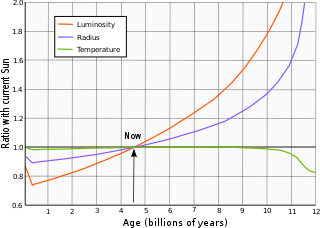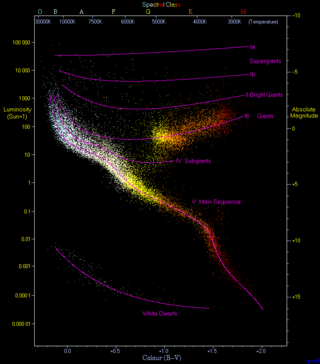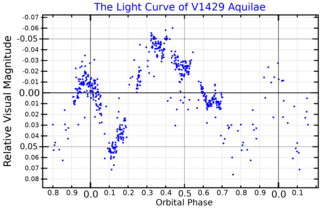
A globular cluster is a spheroidal conglomeration of stars that is bound together by gravity, with a higher concentration of stars towards its center. It can contain anywhere from tens of thousands to many millions of member stars, all orbiting in a stable, compact formation. Globular clusters are similar in form to dwarf spheroidal galaxies, and though globular clusters were long held to be the more luminous of the two, discoveries of outliers had made the distinction between the two less clear by the early 21st century. Their name is derived from Latin globulus. Globular clusters are occasionally known simply as "globulars".

Luminosity is an absolute measure of radiated electromagnetic energy per unit time, and is synonymous with the radiant power emitted by a light-emitting object. In astronomy, luminosity is the total amount of electromagnetic energy emitted per unit of time by a star, galaxy, or other astronomical objects.

Supergiants are among the most massive and most luminous stars. Supergiant stars occupy the top region of the Hertzsprung–Russell diagram with absolute visual magnitudes between about −3 and −8. The temperature range of supergiant stars spans from about 3,400 K to over 20,000 K.

Red supergiants (RSGs) are stars with a supergiant luminosity class and a stellar classification K or M. They are the largest stars in the universe in terms of volume, although they are not the most massive or luminous. Betelgeuse and Antares A are the brightest and best known red supergiants (RSGs), indeed the only first magnitude red supergiant stars.

The solar luminosity (L☉) is a unit of radiant flux conventionally used by astronomers to measure the luminosity of stars, galaxies and other celestial objects in terms of the output of the Sun.

The cosmic distance ladder is the succession of methods by which astronomers determine the distances to celestial objects. A direct distance measurement of an astronomical object is possible only for those objects that are "close enough" to Earth. The techniques for determining distances to more distant objects are all based on various measured correlations between methods that work at close distances and methods that work at larger distances. Several methods rely on a standard candle, which is an astronomical object that has a known luminosity.

The red-giant branch (RGB), sometimes called the first giant branch, is the portion of the giant branch before helium ignition occurs in the course of stellar evolution. It is a stage that follows the main sequence for low- to intermediate-mass stars. Red-giant-branch stars have an inert helium core surrounded by a shell of hydrogen fusing via the CNO cycle. They are K- and M-class stars much larger and more luminous than main-sequence stars of the same temperature.

A subgiant is a star that is brighter than a normal main-sequence star of the same spectral class, but not as bright as giant stars. The term subgiant is applied both to a particular spectral luminosity class and to a stage in the evolution of a star.

The red clump is a clustering of red giants in the Hertzsprung–Russell diagram at around 5,000 K and absolute magnitude (MV) +0.5, slightly hotter than most red-giant-branch stars of the same luminosity. It is visible as a denser region of the red-giant branch or a bulge towards hotter temperatures. It is prominent in many galactic open clusters, and it is also noticeable in many intermediate-age globular clusters and in nearby field stars.

IK Pegasi is a binary star system in the constellation Pegasus. It is just luminous enough to be seen with the unaided eye, at a distance of about 154 light years from the Solar System.

An O-type main-sequence star is a main-sequence star of spectral type O and luminosity class V. These stars have between 15 and 90 times the mass of the Sun and surface temperatures between 30,000 and 50,000 K. They are between 40,000 and 1,000,000 times as luminous as the Sun.

HR Carinae is a luminous blue variable star located in the constellation Carina. It is surrounded by a vast nebula of ejected nuclear-processed material because this star has a multiple shell expanding atmosphere. This star is among the most luminous stars in the Milky Way. It has very broad emission wings on the Balmer lines, reminiscent from the broad lines observed in the spectra of O and Wolf–Rayet stars. A distance of 5 kpc and a bolometric magnitude of −9.4 put HR Car among the most luminous stars of the galaxy.

WOH G64 is an unusual red supergiant (RSG) star in the Large Magellanic Cloud (LMC) satellite galaxy in the southern constellation of Dorado. It is the largest known star with a well-defined radius. It is also one of the most luminous and massive red supergiants, with a radius calculated to be around 1,540 times that of the Sun (R☉) and a luminosity around 282,000 times the solar luminosity (L☉).

VY Canis Majoris is an extreme oxygen-rich red hypergiant or red supergiant and pulsating variable star 1.2 kiloparsecs from the Solar System in the slightly southern constellation of Canis Major. It is one of the largest known stars, one of the most luminous and massive red supergiants, and one of the most luminous stars in the Milky Way.

R136a1 is one of the most massive and luminous stars known, at nearly 200 M☉ and nearly 4.7 million L☉, and is also one of the hottest, at around 46,000 K. It is a Wolf–Rayet star at the center of R136, the central concentration of stars of the large NGC 2070 open cluster in the Tarantula Nebula in the Large Magellanic Cloud. The cluster can be seen in the far southern celestial hemisphere with binoculars or a small telescope, at magnitude 7.25. R136a1 itself is 100 times fainter than the cluster and can only be resolved using speckle interferometry.

AB7, also known as SMC WR7, is a binary star in the Small Magellanic Cloud. A Wolf–Rayet star and a supergiant companion of spectral type O orbit in a period of 19.56 days. The system is surrounded by a ring-shaped nebula known as a bubble nebula.
This glossary of astronomy is a list of definitions of terms and concepts relevant to astronomy and cosmology, their sub-disciplines, and related fields. Astronomy is concerned with the study of celestial objects and phenomena that originate outside the atmosphere of Earth. The field of astronomy features an extensive vocabulary and a significant amount of jargon.

V1429 Aquilae is a candidate luminous blue variable multiple star system located in the constellation of Aquila. It is often referred to by its Mount Wilson Observatory catalog number as MWC 314. It is a hot luminous star with strong emission lines in its spectrum.

AB8, also known as SMC WR8, is a binary star in the Small Magellanic Cloud (SMC). A Wolf-Rayet star and a main sequence companion of spectral type O orbit in a period of 16.638 days. It is one of only nine known WO stars, the only Wolf-Rayet star in the SMC not on the nitrogen sequence, and the only Wolf-Rayet star in the SMC outside the main bar.

HD 326823, also known as V1104 Scorpii, is a binary star containing a unique emission-line star, which is in the midst of transitioning to a nitrogen-rich Wolf-Rayet star, as well as being a candidate Luminous blue variable, located 4,142 light years away in the constellation of Scorpius. The primary is very evolved, because it is composed of almost entirely helium, and only 3% of it is still hydrogen, and it has lost most of its mass to the now-very-massive secondary. The underlying mechanisms and mass transfers in the system are comparable to other W Serpentis systems, such as Beta Lyrae and RY Scuti.

















